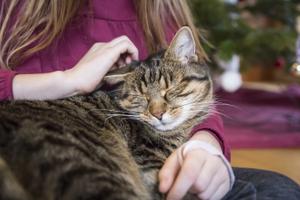

虽然研究表明,毛发的长度和颜色对 Fel d 1 的产生没有影响,但有一个生理因素似乎确实存在关联:猫的性别。1-6
事实
一些研究表明,性别与 Fel d 1 的产生相关。
- 研究表明,无论其绝育状态如何,雄性猫产生的 Fel d 1 水平通常高于已绝育/阉割的雄性猫和雌性猫。1,6-9
- 但是,每只猫的 Fel d 1 水平因遗传因素而异,正常雄性猫产生的 Fel d 1 可能会低于高产雌性或绝育雄性猫。1,6,8-11
了解更多信息
- Kelly, S.M., Karsh, J., Marcelo, J., Boeckh, D., Stepner, N., Litt, D.,...Yang, W.H. (2018). Fel d 1 and Fel d4 levels in cat fur, saliva and urine. Journal of Allergy and Clinical Immunology. doi: 10.1016/j.jaci.2018.07.033
- Bonnett, B., Messaoudi, K., Jacomet, F., Michaud, E. Fauquert, J.L., Caillaud, D., & Evrard, B. (2018). An update on molecular cat allergens: Fel d 1 and what else? Chapter 1: Fel d 1, the major cat allergen. Allergy, Asthma and Clinical Immunology, 14, 14. doi: 10.1186/s13223-018-0239-8
- Butt, A., Rashid, D. & Lockey, R. (2012). Do hypoallergenic cats and dogs exist? Annals of Allergy Asthma and Immunology, 108, 74-76.Fel D 1
- Nicholas, C., Wegienka, G. & Havstad, S. (2008). Influence of cat characteristics on Fel d 1 levels in homes. Annals of Allergy Asthma and Immunology, 101, 47-50
- Siebers, R., Healy, B., Holt, S., Peters, S., Crane, J. & Fitzharris, P. (2001). Fel d 1 levels in domestic living rooms are not related to cat color or hair length. Journal of Allergy and Clinical Immunology, 108, 652-653. doi: 10.1067/mai.2001.118788
- Platts-Mills, T.A.E., Vervloet, D., Thomas, W.R., Aalberse, R.C. & Chapman, M.D. (1997). Indoor allergens and asthma: report of the Third International Workshop. Journal of Allergy and Clinical Immunology, 100, S2-S24. doi: 10.1016/S0091-6749(97)70292-6
- Zielonka, T., Charpin, D., Berbis, P., Luciani, P., Cassanova, D. & Vervloet, D. (1994). Effects of castration and testosterone on Fel d 1 production by sebaceous glands of male cats: I. Immunological assessment. Clinical and Experimental Allergy, 24, 1169-1173
- Ramadour, M., Birbnaum, J., Magalon, C., Lanteaume, A., Charpin, D. & Vervloet, D. (1998). Cat sex differences in major allergen production (Fel d 1). Journal of Allergy and Clinical Immunology, 10, 282-284.
- Jalil-Colome, J., de Andrade, A.D., Birnbaum, J., Casanova, D., Mege, J.-L., Lanteaume, A., Charpin, D., & Vervloet, D. (1996). Sex difference in Fel d 1 allergen production. Journal of Allergy and Clinical Immunology, 98(1), 165-168.
- Morgenstern, J.P., Griffith, I.J., Brauer, A.W., Rogers, B.L., Bond, J.F., Chapman, M.D. & Kuo, M.C. (1991). Amino acid sequence of Fel dI, the major allergen of the domestic cat: protein sequence analysis and cDNA cloning. Proceedings of the National Academy of Sciences, 88, 9690-9694.
- Bastien, B., Gardner, C. & Satyaraj, E. (2019). Influence of phenotype on salivary Fel d 1 in domestic shorthair cats. Accepted, Journal of Feline Medicine and Surgery.